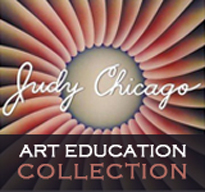Forum Replies Created
-
AuthorPosts
-
September 4, 2014 at 3:32 pm in reply to: 1. Relationship between art, art history and art education programs? #3867
JCAEC
KeymasterJCAEC
KeymasterHello Again Deandra,
I am so excited to hear back from you! Please contact me at my e-mail dpcp@throughtheflower.org. I look forward to hearing your questions.
-Hannah
JCAEC
KeymasterGlad you all liked it!
JCAEC
KeymasterThank you for joining our community! Are you a teacher? And do you plan to use the Dinner Party Curriculum in your classroom or anywhere else this year? Does your role as a mother change how you see women’s history and the importance of passing it on?
-Hannah
JCAEC
KeymasterWould any new or old member care to introduce yourself? I would love to get some conversations started. Check out the recent posting under the category, “Conversations.” You can read all about the CentrePompidou in Paris. They have rehung their entire modern and contemporary collection from a woman’s perspective. They are especially focusing on women’s art. The article is fabulous and from a very interesting feminist resource, The F-Word, a magazine and blog. I’m sure everyone will enjoy this piece of news.
And once again, please introduce yourself, I would love to meet any member of the Forum!
-Hannah

JCAEC
KeymasterWelcome Ankit! Check out our new Conversations topic to read interesting news about women in the arts. Do you have any comments or questions about The Dinner Party Curriculum?
-Hannah

JCAEC
KeymasterArt News
The Chicago School of Art
The K-12 Dinner Party Curriculum
By Erin Adair-HodgesPanels from The Dinner Party The development of The K-12 Dinner Party Curriculum Project was born out of frustration.
While Judy Chicago, developer of The Dinner Party, and her husband, photographer Donald Woodman, were artists in residence at Vanderbilt University in 2005, Chicago was shown an article from an education magazine on a teacher’s use of The Dinner Party in class.Chicago’s work consists of a triangular table with place settings set for important female figures, such as Emily Dickinson, Kali, Sacajewea and Eleanor of Aquitaine. One of the intentions of the installation is to highlight the oft-ignored contributions of women, so when Chicago saw that this teacher’s class had instead created their own autobiographical plates, she was disturbed. There’s nothing wrong with that approach, she writes in an introduction to the curriculum, but “it is a mistake to claim that such a project has anything to do with The Dinner Party, which is about women’s achievements in history.”
The Dinner Party He response to the class project spurred her to think about developing guidelines for educators who want to use The Dinner Party, as many have done since the project’s completion in 1979. She and Woodman began working with Constance Bumgarner Gee, a professor of education at Vanderbilt. The hope was to guide students’ interactions with the piece in a way that honored the original intention of saving the role of powerful women from obscurity.
The Dinner Party itself was born out of collaboration, taking five years and the work of hundreds of people to come to fruition. The curriculum developed along a similar course, bringing in the experience and insight of educators. Chicago and Gee approached Kutztown University’s Marilyn Stewart, Peg Speirs and Carrie Nordlund to direct the project. They in turn enlisted a host of K-12 teachers to work together on developing lessons surrounding The Dinner Party. The teachers went back to their classrooms and implemented the strategies, highlighting what worked and refiguring what didn’t. The final curriculum is a product of this highly synergetic process.
The Dinner Party One aspect that both Chicago and the curriculum’s developers stress is the examination of content and context. Chicago says modern art education is obsessed with form—that is, how to create art—prioritizing format and technique. As an artist, she focuses on content (what the piece is saying) and the context of its creation (why it’s saying it, who it’s saying it to). The curriculum then asks students to investigate metaphor, symbolism and history as a way to understand the work’s meaning.The teaching of women’s history and achievements is often ghettoized, shoved into segments and special months, rarely integrated as part of a comprehensive program. The K-12 Dinner Party Curriculum Project isn’t slaying that particular behemoth, but it does attempt to create a space where students can realize that history isn’t just created by wars and shifting borders, but also by poetry, resistance and silent sacrifice.
Another goal of the program is to “emphasize that there are many ways to be involved in art,” Chicago says. “When it’s only hands-on art-making and they don’t end up being artists, they don’t have any other ideas that they could have a lifetime involvement with art other than making it.” Chicago, Woodman and the curriculum’s developers want to open students up to a world where participation in art includes curation, criticism, appreciation and patronage.
“There are all kinds of ways to be involved in art,” she says. “Hundreds of thousands of people who have seen The Dinner Party had a profound change and they learned a lot, and that’s what art should do.”
The K-12 Dinner Party Curriculum Project was officially launched on May 1 at the Roundhouse in Santa Fe. For more information on the curriculum, go to throughtheflower.org/dpcp.
JCAEC
KeymasterWhat’s a Feminist Like You Doing in a Place Like This?
Judy Chicago’s Belen vs. The Hometown I Narrowly Escaped
By Erin Adair-Hodges
There’s a 1971 photo of Judy Chicago taken by Jerry McMillan that shows her dressed like a boxer in a ring. She stands in the corner, her arms crooked back over the ropes, gloved hands dangling. Her chin is thrust forward and her eyes challenge the camera and, presumably, anyone else. Across her shirt is emblazoned in block, gym-class letters, “JUDY CHICAGO.” It’s badass.
For nearly 40 years, Judy Chicago has been considered an icon in feminist art. Her 1979 work The Dinner Party—a banquet arrayed on a triangular table, each place setting honoring an important woman in history—is considered one of the most important symbols of that movement and has been seen by more than one million people.The current focus of Chicago’s considerable energy is the development of a curriculum attached to The Dinner Party for grades K-12. The goal of the project is to provide educators with a way to engage students in art not just on a formal level, concentrated on making it, but allowing them to appreciate art within the context of its creation. It’s vital to her. “Art creates meaning in life,” she says. (See the Arts section for more on “The K-12 Dinner Party Curriculum.”)
I first encountered the work of Judy Chicago as a college freshman in a women’s studies class where we read her autobiography Through the Flower: My Struggle as a Woman Artist. Though it had been published 18 years earlier, I felt a deep connection to this book, to Chicago’s ferocity in the face of attempts to marginalize or render irrelevant the work of women exploring women’s issues. It may have been the early ’90s, but in New Mexico, it often seemed as if feminism had never happened. At 17, lacking in self-confidence and in need of some artistic godmothers, Judy Chicago became one of mine.
My own experience is far from singular. It’s interesting only in that Judy Chicago now lives in Belen, New Mexico. Which is surprising, since I grew up there and have long considered it to be the worst place on earth.
Hub City
Let me explain.
Belen lies 30 miles south of Albuquerque, along the Rio Grande. Spanish for Bethlehem, its nickname is the Hub City because it served as the cutoff of the Atchison, Topeka and Santa Fe Railway, allowing more trains to easily travel east and west. I don’t think anyone calls it that anymore.Belen has always been a railroad town. Before the train arrived in 1880, Belen was just a stop, collections of people waiting for something to happen. My own family had been in Texas and Oklahoma as far back as we can trace, part of the early waves of European Americans making their way West, pulled by opportunity and pushed by desperation. They first came to New Mexico in the late 1800s, but the hard life drove some of them back to the comparative comfort of red-hilled Oklahoma.
We first make the scene in Belen in the form of my grandfather, Benny Hodges, in 1928. At 15, he jumped a train in Anadarko, Okla., headed for anywhere. The railroad bulls threw him out in Belen, where he was taken in by the Sichler family and worked on their farm for rent. Later, he also drove the school bus, where he met a high schooler named Mary Ellen, who would become my grandmother.
Growing up, I was surrounded by my entire family on both sides—grandparents Adair and Hodges (save for Benny, who died in ’69), aunts and uncles, dozens of cousins. My father Ron, as high school principal, was small-town important. I rode my bike everywhere, neighbors knew who I was and looked out for me. And yet, I never felt as if I belonged in Belen. I was red-haired, freckled, grade-skipped, book-obsessed. Though I was born there, I was constantly aware that in some ways, I would always be an outsider.
Donald Woodman
“Looking at the Los Lunas Hill from the North,” watercolor, © Judy Chicago 1996 Ghosts
I drive down to Belen to meet Judy Chicago on a windy April day. She’s very graciously agreed to meet with me to talk about the convergence of identity, place and art. Ever since I found out that Chicago had made her home in the place I fled, I’ve been obsessed with finding out why.
People have complicated relationships with their hometowns. I know that. But Belen isn’t some charming, sleepy small town. It’s no Grovers Corners, all picket fences and homey wisdom. Maybe it was, once. In some ways, it had a bit of that in my childhood. There was one pharmacy, one bakery, one New Mexican restaurant and everybody knew everybody. But by the time we left in ’91, Wal-Mart had just come in and many of the local stores were in decline.I haven’t been back in a long time. My grandparents are gone, the one still living moved away. I have some extended family there, but no center, no home.
I arrive a bit early so I can drive around. There are few places still about from my tenure; at least, the buildings are still there, but the businesses are largely replaced by newer ones with hurried signs. Many of the storefronts are empty. I drive by my Grandma Hodges’ house, built by my grandfather and in which some other family now lives. Mary Ellen would be aghast at the state of the bushes.
Judy Chicago and Donald Woodman live in the old Belen Hotel, in what’s considered only in pamphlets to be Belen’s Downtown. They argue over the year they bought it, so it’s safe to say the early ’90s, just as I was hightailing it out, leaving only cartoon dirt clouds behind. The hotel had been abandoned my entire life, and years before that. It stands on the same block as Eva’s Market, where we bought our red chile and meat, and Sugar Lanes Bowling Alley, where I learned to bowl in seventh-grade P.E. Both the market and the alley are closed, their owners too old to keep things up, with no one else to take the reins.
The Welcoming Party
Just east of the bowling alley is Through the Flower, the feminist nonprofit organization begun by Chicago to promote arts education. Though the center’s executive director, Susannah Rodee, has set up my meeting with Chicago, she won’t be there, and so I’m meeting Ms. Chicago on my own. As I arrive, she greets me and asks me to wait a bit as she struggles with the printer. She has to send off a draft of a book she’s working on. I’d like to help, I tell her, but admit that usually I have my husband do those things.
“Me, too,” she laughs. I’m heavily aware of the irony; a couple of feminists calling their husbands to fix machinery. She’s about to get on the phone and invite him over when a group of three people in their early 60s come in. They chat as I look around. Chicago asks them to hold on for a sec while she calls her husband. Polite but incredulous, one of the women in the group asks, “You have a husband?”She has a husband, the photographer Donald Woodman, to whom she’s been married for almost 24 years. He comes over to fix the printer and I notice that they both have distinctly un-Belen hairdos. Donald’s is dark but bleached in the front, while Judy’s tight curls are cut short, save for a few long pieces tendriling at will, streaks of magenta and blonde throughout. I assume they get their hair done when they’re out of town, only to find out later that their hairdresser, Ronnie Torres, is also Belen’s mayor.
Printer fixed and job done, we walk over to the hotel, which they’ve converted into a gallery, studio and living space for themselves. Chicago describes it as “kind of a mom-and-pop shop,” where they “live above the business.” We walk through their home, tastefully restored and converted, and down into the courtyard.
“Do you know,” I tell Chicago as we sit down, “that prostitutes used to live here?”
“It’s true,” Woodman says as he joins us. “There was a pool hall across the street. They lived where we have the guest rooms upstairs.”
“Oh! In our building?”
I nod. “They greeted the railroaders as they got into town.”
Chicago laughs. “I didn’t know that. That’s a great story.”
Donald Woodman
Sen. Michael Sanchez introduces Judy Chicago to a crowd of 150 people assembled in the rotunda of the New Mexico state capitol in Santa Fe, N.M. for the national launch of the K-12 Dinner Party Curriculum, May 1, 2009.
Close Enough
Why Belen? After the opening chitchat, it’s the first question I ask.
“I have a big life in the world, so I need a place to come back to,” Chicago says. “It’s hard in a big city to maintain quiet and focus.”“But why Belen? Why not Silver City, or …”
Chicago’s answer is immediate. “Too far from the airport. Way too far from the airport.”
Before that, Woodman tells me the couple had been living in Santa Fe but could no longer afford to live there. “Judy wanted to go back to L.A., and I didn’t want to go to a big city and insisted we stay in New Mexico.” He’s lived in the state since 1972. Chicago first came out in the ’80s, just for a short visit.
“You know,” she says, “my story is the regular New Mexico story. I came for a few weeks and then a few months and then I was living here but all my stuff was still in California. I mean, I never thought I would end up living in New Mexico.” They married, then looked for a place to settle. Woodman was tired of renting, but for Chicago, proximity to Albuquerque was key. “It’s really hard to make a living in New Mexico; so I have to travel a lot, and I wanted to be somewhere that was psychically private and quiet but was not far from the airport.” I consider recommending this approach to the town’s tourism board: Belen, Close Enough to Get the Hell Out.
Weeks later, as I’m writing this piece, Chicago calls me to clarify a few things, most importantly the fact that she and her husband like it there. “It’s our home, and we’re committed to living here.” They tout Belen’s friendliness, its small-town vibe. “We love it here.” I can feel however I want about Belen, Chicago tells me, but that’s not how they feel. It’s an awkward moment.
Through the Flower, Inside-Out
Chicago loves her hotel, and they’ve carved out a beautiful space, but she’s well aware of the challenges of living here. That’s partly what drew them. “Some places have too much art, and other places don’t have enough. So I was really interested in trying to rebuild connections in the art community. Which is something we’ve slowly been doing here.” Through the Flower has held art conversations and exhibitions and has been bolstered by the arrival of the Rail Runner two blocks away. “Now that we didn’t expect,” she laughs.
“A happy accident,” I offer.“A mixed accident,” she says. “But it’s great for Through the Flower; we’ve already been getting people here from Santa Fe. You know, our big joke is that it’s easier to get people here from China than it is from Santa Fe.” Because of the Rail Runner, many people made the two-hour train trek to their last event.
“But you should know,” Woodman says, “that there were a lot of people from Los Lunas, from the community. There are a lot of artists down here, and Through the Flower also does professional training classes for artists.” It’s important to them that the immediate community is involved.
I point out that when we talk about the connections between art and community, it can get a bit abstract. “So,” I begin, “in a community that has traditionally been, I don’t want to say inhospitable, but it’s not the most nurturing place …”
Chicago stops me. There’s an income and education gap here, she says. It’s true—and in parts, it’s much poorer than I remember. “That’s one of the reasons I write for the News-Bulletin [Valencia County’s newspaper]… about TTF and what we’re doing and invite people to come. But you know, it took awhile, I have to say. Because, you know from living here, there’s a suspicion of anyone who comes from the outside.”
I do.
Donald Woodman
Judy Chicago facilities a discussion with audience members during one of Through the Flower’s Art Conversations, at its headquarters/gallery in Belen, NM. Through the Flower’s Art Conversations draw people from Belen and surrounding communities as well as from communities from around the state. Visitors to Through the Flower come from all around the world Main Street
Belen’s history extends back to a 1740s Spanish land grant, and there are many families in town who claim that heritage. Until relatively recently, agriculture in Belen was rivaled only by the railroad in importance. At least a third of the kids in my high school wore Wranglers and Rockies and cowboy boots. I once wore a pair of boots my aunt had given me to school and was teased so mercilessly that I shoved them to the back of my closet, hiding the mistake from myself. You didn’t just decide to one day wear boots; you were either a person who wore them, or you weren’t.
Today, Belen’s biggest employers are Wal-Mart and the school system. According to the 2000 U.S. census, 68.6 percent of Belen residents are Hispanic. Almost 10 percent have a bachelor’s degree, roughly the same number as people who have less than a ninth-grade education. A quarter of individuals and a quarter of all families in Belen live beneath the poverty line.There is no correlation between the town’s ethnic makeup and its income level. These are numbers, and much about a town cannot be seen in percentages. But parts of it can.
Chicago credits her husband for providing a smooth introduction to the town. “[He] got us off to a good start. He hired all local help when he was working on the building. He got to know a lot of the people here.”
“Judy insisted we organize it in the way she does a lot of her projects,” Woodman says. “Right in the middle of demolition we had an open house, put something in the paper, invited anyone in town to come.”
“We had a lot of people.”
“We told them what we were going to do, would show them, just make them feel invited,” Woodman adds.
“There was this one moment,” Chicago recalls, “when these three little girls said to me, ‘Are you gonna have art classes?’ So I said, ‘Well, you know, we hadn’t really planned on it, but why?’ And this one little girl says, ‘I could be a really good artist if only I could get classes.’ ” I smile and nod. I tell them I know the feeling of living in a place outsized by my ambition.
“I remember when I was a child,” she says. “I grew up in Chicago, and my mother sent me to the Chicago Art Institute. Even though we didn’t have any money, she made sure I could do that. … That’s what you’re talking about. It’s coming, but it’s just really slow. If Belen becomes part of the MainStreet Program, it will accelerate it.”
Woodman explains that the MainStreet Program is “a collaboration between the state and National Trust for Historic Preservation.” The project provides support for people in communities in decline, including urban planning and financial advice. He gives as examples Silver City and Nob Hill in Albuquerque. The project enables access to services out of reach for many small businesses and educates about the impact of aesthetic quality. “This community is ready for this kind of thing.”
Mayor Ronnie Torres, Chicago says, has been this project’s biggest champion. His work is responsible for one of the few upgrades I’d noticed in town: the “Heart of Belen.” It’s a sort of pagoda area that leads into Becker Avenue, a block from the church I grew up in and was last at for a funeral. I like the improvement; its intentions are clear, an attempt to counter haphazard growth.
The Very Idea
Throughout our conversation, Chicago and Woodman periodically stop to yell at one of their cats; they’re trying to keep them from jumping over the fence. It’s not a good idea to let your pets out in Valencia County, they say, because of what happens. They’re not more specific and I do not ask.
Chicago strikes me as a pragmatic idealist. She is aware of the challenges of this place yet at the same time sees vast reserves of potential. Through The Flower has a research library installed at UNM Valencia Campus. “Grown to over 2,100 volumes,” she says, all dedicated to women and art. The organization is also spearheading the development of the NM Women’s Cultural Corridor that would move up the spine of the state. “It’s one of the ways in which we’re trying to create greater integration in the art community.”I ask about the reception of art here. “Well,” Chicago says, “it’s not so much reception as what their idea of art is. You know, like, there’s a lot of amateur art here … and that’s an area that needs a long education process.” This isn’t disparaging: It’s about education and access.
The second part of my question, and more important to me, is how the town responds to her not just as an artist, but as a feminist artist. “I’m not sure, actually, that people understand what that means.” There’s no hostility whatsoever, and she says residents are very proud that a famous artist lives in their town. Rather, the understanding of feminism and art is, well, vague.
“But you can go anywhere in this country,” Woodman says, “it doesn’t have to be Belen, and find people who art’s important in their life and people that are totally indifferent to art.”
“There are people here, everywhere, who are interested,” Chicago says. “But I can understand it would be hard to grow up here.”
Signifiers
Judy Chicago was born Judy Cohen in Chicago, Ill. She took her first husband’s name, Gerowitz, and made art under that name in Los Angeles in the early ’60s, where she earned a master’s from UCLA in painting and sculpture. “But he died within a couple of years,” she says, “so then I felt like I didn’t have a name.” Her first gallery dealer had begun calling her Judy Chicago because of her accent, and so, in 1970, a full-page ad in Artforum announced the name change from Gerowitz to Chicago to dispossess “herself of all names imposed upon her through male social dominance.”
She doesn’t mention the ad when we meet. Instead, she focuses on the organic nature of her name change. “When the women’s movement started and I wanted to change direction in my work, I thought I wanted to do something symbolic, and so I kind of formalized the name. And it was really right. And then I felt like I had a name.”“You named yourself,” her husband adds.
“It just seemed right for me,” Chicago says. “I mean, I didn’t change my identity, but it became a symbol for who I was all along.”
They admit that people, especially in New Mexico, can sometimes have difficulty in understanding this. Woodman gets called Mr. Chicago, while Chicago gets Mrs. Woodman. I understand, I say, because I have a hyphenated name, neither of which is my husband’s. I explain that as a teenager, I took my mother’s name of Adair (while she herself was still Mrs. Hodges) as a way to acknowledge my full identity and subvert claims of patriarchal ownership, blah blah blah.
“No wonder you wanted to get out Belen,” she says.
“I know. Can you imagine?”
“Yeah, no,” she laughs. “Especially not then.”
It’s around this time that I feel as if I’m having a real conversation with a talented woman whom I deeply admire, but as much as we’re seeming to connect, we are talking about two different places. Chicago and Woodman’s Belen is postmillennial, still traditional in many ways but by no means a backwoods. My Belen is the one of the ’70s and ’80s, a town caught in transition between its rural past and its suburban future. The speed limit on the interstate was 55, and Albuquerque was another world. My early exposure to feminism came from my mother, a woman born in England and raised in New England. This made me acutely aware of the fact that there was a whole wide world that did not operate the way my town did. But as a kid, you’re powerless to leave.
I realize like a lightning bolt why I don’t come back, why I’ve had to distance myself from here. That’s what Belen makes me feel: powerless.
We’re Here
Belen has welcomed Chicago and Woodman, but it was by no means immediate. “It’s taken a really, really long time. Years,” Chicago explains. They say that there have been definite moments of culture clash. “But that’s changed.” People are cordial, they reach out. “We like that we can call Buckland’s [the old pharmacy] after they’re closed and they’ll fill our prescription,” she tells me later on the phone. It’s their home.
In a way, the couple has been embraced for their difference, and definitely for their success. At the launch of the K-12 Dinner Party Curriculum in Santa Fe on May 1, the mayor and several other Belenites were in attendance, and state Sen. Michael Sanchez, also from Belen, introduced Chicago.I admire that part of what attracts Chicago and Woodman to Belen is the challenge it presents. We look at the same town and both see bones, but whereas mine are remnants, theirs are bones for building on.
In Belen, there’s nowhere you can sleep without hearing the train. It is a sound that’s so familiar, it’s a kind of lullaby. The train has brought people to Belen and to Through the Flower, and so it’s a boon for Chicago and her work. But it brought me to Belen as well. I’ve always felt as if I were thrown off here, like my grandfather, pushed into this place. But Judy Chicago and Donald Woodman are here by choice and are making a mark. They’re exercising power. I could not do that, and I cannot blame Belen. It was the wrong stop for me, but, I realize, not for everyone.
“We’re here,” Chicago affirms. “And we’ve been here long enough that I think people know we’re not going to leave.”
JCAEC
Keymaster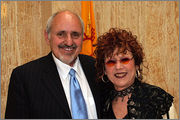
Stuart Ashman, Secretary of the New Mexico Department of Cultural Affairs, MC for the afternoon event with Judy Chicago.
JCAEC
Keymaster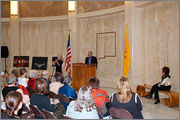
Senator Michael Sanchez enthusiastically introduces Judy Chicago to the crowd assembled in the rotunda of the New Mexico State Capitol in Santa Fe, NM.
JCAEC
Keymaster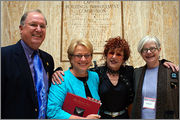
Senator Michael Sanchez, New Mexico State Senate majority leader, his wife, elementary school teacher, Lynne Sanchez, Judy Chicago and TTF Board President, Mary Ross Taylor.
JCAEC
Keymaster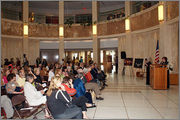
Judy Chicago addresses the gathering of 150 people at the formal launch of the DPCP K-12 in the rotunda of the New Mexico State Capitol, attended by art professionals, museum curators, political dignitaries, the Board of Through the Flower and many art teachers from around New Mexico.
JCAEC
Keymaster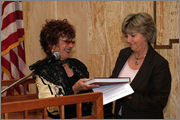
Judy Chicago presenting a Dinner Party book to New Mexico Lt. Governor Diane Denish in appreciation for her remarks and support.
JCAEC
KeymasterFrom Patrice Emrie, president of the New Mexico chapter of the National Museum of Women in the Arts.
The Curriculum launch was a huge success. You must feel so proud. The turnout was great, the show of support is just amazing. Judy, the footprint that you are making in this world is enlarging. How wonderful to share The Dinner Party and women’s history with a whole, new, young generation. Congratulations.
Warmly,
PatriceJCAEC
KeymasterAfter the event Through the Flower received numerous congratulations which we appreciate and would like to share with the Forum.
The following is from Betsy Ehrenberg, art collector and founder of Santa Fe Glass Alliance“Getting the thousands of educators to downloadthe files will generate another milestone – one where the “bloggers” and the “twitters” will facilitate this effort. Getting the real winners into the White House might not be your goal, but it might happen nevertheless.”
Congratulations from
Betsy -
AuthorPosts
